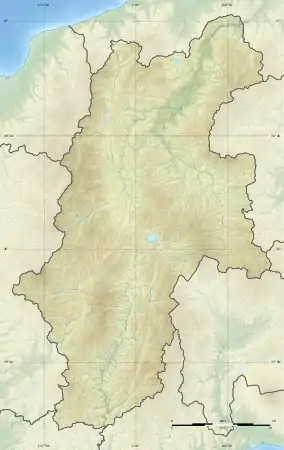Sano ruins
Sano Ruins (佐野遺跡, Sano-iseki) is an archaeological site containing the ruins of a late-Jōmon period settlement located in what is now part of the town of Yamanouchi, Nagano in the Chūbu region of Japan. The site was designated a National Historic Site of Japan in 1976.[1]
佐野遺跡 | |
 Sano Ruins  Sano ruins (Japan) | |
| Location | Yamanouchi, Nagano, Japan |
|---|---|
| Region | Chūbu region |
| Coordinates | 36°43′56″N 138°24′26″E |
| Type | settlement |
| History | |
| Periods | Jōmon period |
| Site notes | |
| Ownership | National Historic Site |
| Public access | None |
Overview
The site is located in the southern portion of Yamanouchi Basin, where the Yamase River flows down from the Shiga Highlands. In the late 1930s, the discovery of Kamegaoka pottery from far northern Mutsu Province at this location attracted considerable attention, indicating long distance trade during the Jōmon period. Subsequent excavation surveys have uncovered the traces of a large-scale settlement, and further examples of a distinctive local style of pottery, which was named the "Sano style". In the Shinano region, ruins from the middle Jōmon period (3000–2000 BCE) are numerous, but the number drops drastically during the late Jōmon period (2000–1000 BCE).
The site is located approximately ten minutes by car from Yudanaka Station on the Nagano Electric Railway, but is only an open field with a stone marker.
References
- "佐野尻遺跡" (in Japanese). Agency for Cultural Affairs.
External links
- Yamanouchi town official site (in Japanese)